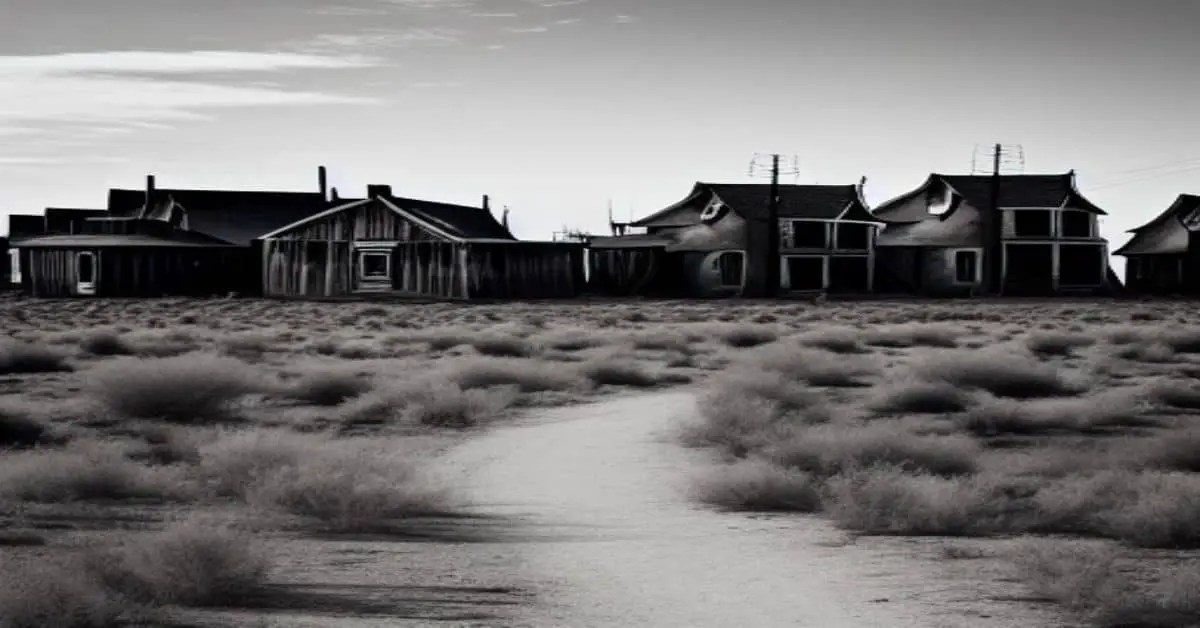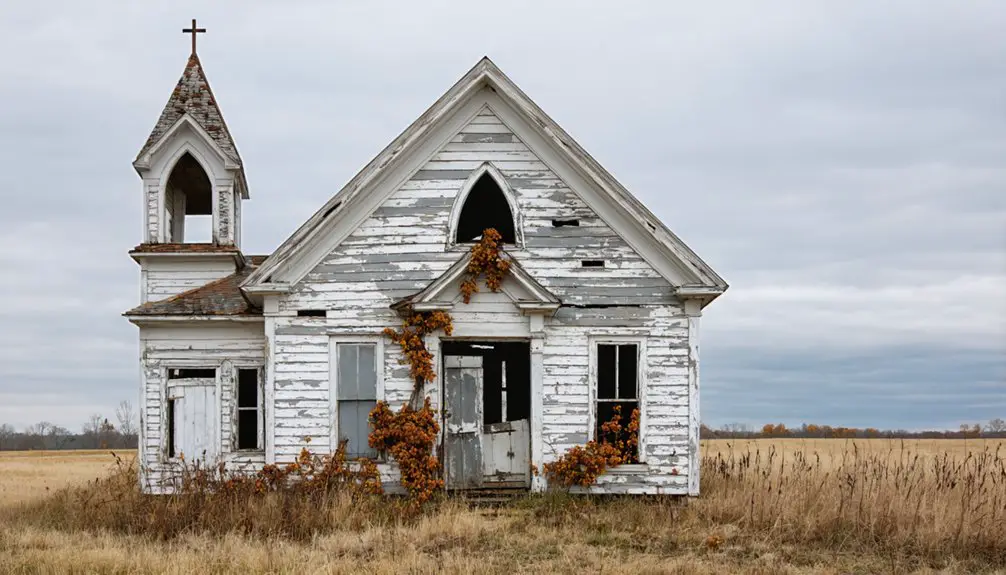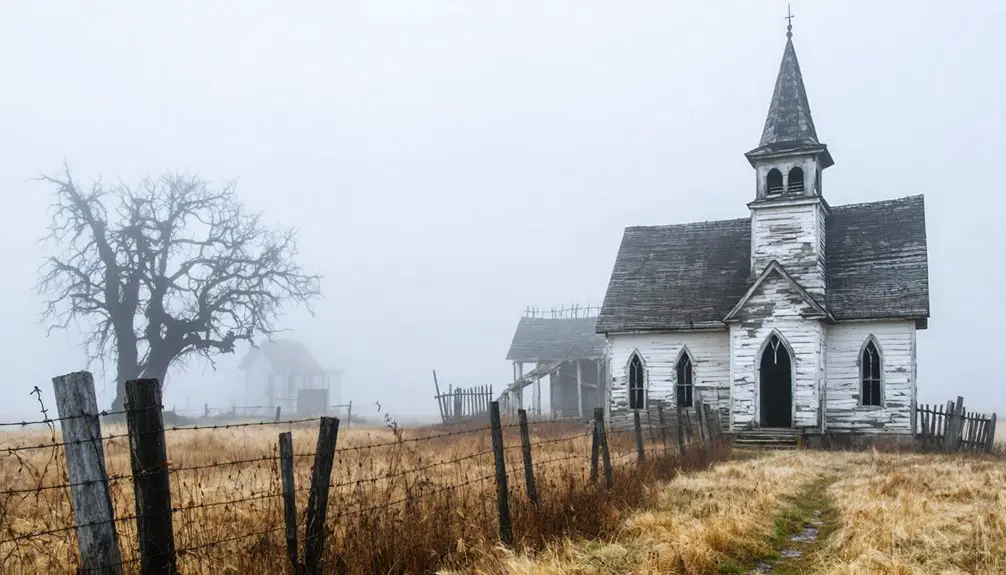You’ll discover Saint Annie, Missouri near the Texas County line, where Irish farming families established a vibrant community in the late 1800s. The settlement featured a post office (1878), Catholic and Baptist churches, and a general store serving local agricultural families. After facing economic challenges and isolation, Saint Annie gradually declined following the Great Depression and WWII. Today, you can explore the old school’s foundation, Macedonia Christian Church cemetery, and store remnants—though the site’s rich history holds many more untold stories.
Key Takeaways
- Saint Annie was established in late 19th century Pulaski County, Missouri, near the Texas County line at coordinates 37.57198, -92.27405.
- The town featured a post office (1878), general store, school, and two churches serving as community hubs until decline.
- Irish immigrants established significant Catholic presence, building St. Ann Catholic Church with English Gothic architecture reflecting their heritage.
- Economic challenges, agricultural mechanization, and isolation from major transportation routes led to the town’s eventual abandonment.
- Today, visitors can explore foundations of Saint Annie School, Macedonia Christian Church cemetery, and general store remnants.
The Birth of a Rural Settlement
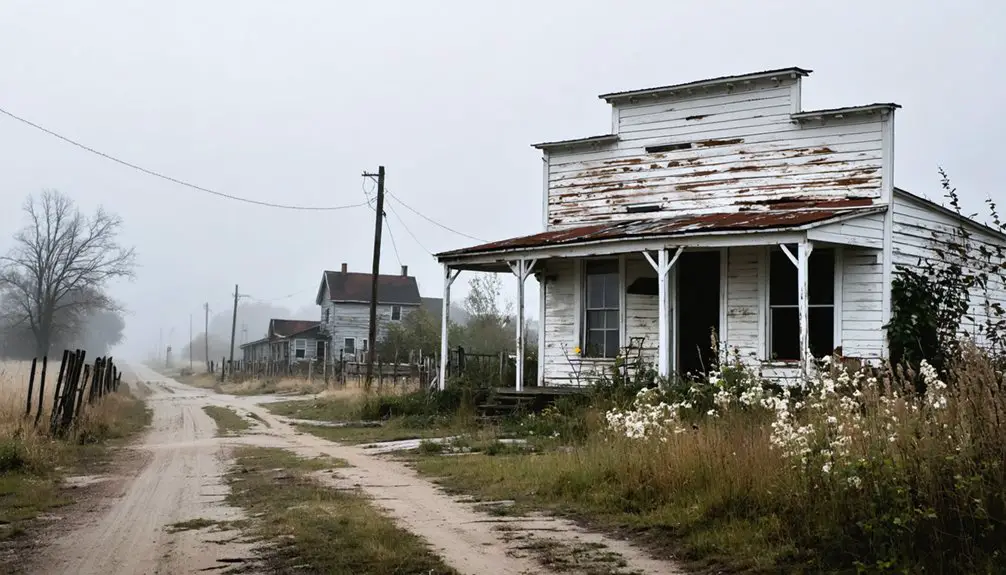
As the late 19th century brought waves of settlement to southwest Missouri, Saint Annie emerged as a modest rural community in Pulaski County, just three miles east of Nebo along what would become Route U.
Positioned near the Texas County line at 37.57198 latitude and -92.27405 longitude, this settlement’s origins reflect the era’s pattern of rural development.
Located along Missouri’s rolling frontier, Saint Annie exemplifies the quintessential rural settlements that shaped America’s heartland expansion.
You’ll find the community’s formal recognition came in 1878 with the establishment of a post office, marking Saint Annie’s place on the map.
The settlement’s name draws from Saint Anne, mother of the Virgin Mary, highlighting the religious community influences of the area’s early settlers. The Ramsay collection provides valuable documentation of how places like Saint Annie received their names.
The landscape proved ideal for farming, and while the town never incorporated, it served as an essential hub for local agricultural families seeking their independence on Missouri’s fertile soil.
Like many rural communities of its time, Saint Annie included essential amenities such as a general store and school.
Life in 19th Century Saint Annie
If you’d walked through Saint Annie in the late 1800s, you’d have seen farmers tending their fields from dawn to dusk, working the rich soil west of the Mississippi.
Your daily routines would’ve centered around agricultural cycles, with breaks only for meals and essential chores. A small group of Irish farming families originally established the tight-knit community.
You’d have found respite and community at St. Ann parish, where religious gatherings offered both spiritual renewal and social connection, despite the economic hardships facing the rural settlement. The parish hosted vibrant concerts and musical events after installing a J.G. Pfeffer pipe organ in 1902.
Daily Farming Activities
Life in Saint Annie revolved around three distinct farming cycles that defined each day’s activities.
You’d start at dawn tending to livestock care – feeding animals, milking cows, and checking fences. During mid-day, you’d focus on crop rotation and field maintenance, using manual tools to control weeds and pests while ensuring proper soil management through companion planting of corn, beans, and squash. The farmers followed the ancient practice of planting these Three Sisters crops together to maximize yields and soil health. Similar to the extension clubs that would later emerge in the region, farmers shared techniques and knowledge with their neighbors.
As evening approached, you’d complete significant tasks like gathering eggs, preserving food, and sorting seeds for next season’s planting.
Women managed vital household agricultural duties while men handled heavy fieldwork. During harvest time, you’d join with neighbors to share labor, working from sunrise to sunset.
Winter months meant moving livestock to sheltered areas and repairing tools while planning for spring.
Religious Community Gatherings
The religious heartbeat of Saint Annie centered around two primary churches established in the late 19th century – the Baptist Church founded in 1891 and a Catholic parish that served as the community’s spiritual anchor.
These churches weren’t just places of worship; they were the social fabric that held Saint Annie together through spiritual gatherings and community rituals. Similar to the First Baptist Church in St. Louis, these churches played pioneering roles in establishing Protestant worship in their regions.
You’d find life-size crucifixes and carved baptismal fonts adorning the stone buildings, where residents gathered for baptisms, marriages, and seasonal festivals.
The churches’ influence extended beyond Sunday services – they hosted school lessons, public meetings, and cultural celebrations.
When disaster struck, like fires or lightning damage, you’d see the community unite to rebuild these sacred spaces, demonstrating their commitment to preserving both their faith and social bonds.
Religious Heritage and Community Identity
When you look at Saint Annie’s origins, you’ll find deep Catholic roots reflected in its namesake Saint Anne, mother of the Virgin Mary.
Unfortunately, many historical records about the town’s religious practices have experienced database connection issues, making detailed information harder to access today.
The town’s 1878 establishment came with religious naming that served as a powerful cultural marker, connecting the community to broader Christian traditions during Missouri’s territorial expansion.
You can trace how this spiritual foundation shaped the town’s identity through its likely observance of Christian holidays and social gatherings, even though specific details about its churches remain unconfirmed.
Like many vibrant communities in Missouri, Saint Annie once had homes, businesses, and places of worship that served its residents before declining into a ghost town.
Catholic Roots Run Deep
Catholic influence in Saint Annie emerged gradually after the Civil War, as Irish immigrants established the area’s first significant Catholic presence in the 1860s. The community’s dedication to their faith manifested in St. Ann Catholic Church‘s construction, which still stands as a symbol of their commitment. Archbishop Peter Kenrick found no Catholics living in the region before 1866.
- The 1887-1888 English Gothic church reflects the Irish architectural heritage
- Fr. Dennis Keily, ordained in Ireland, led spiritual growth in the 1880s
- St. Brenden Catholic School operated until 1939, focusing on faith education
- Catholic festivals centered around the church united the growing community
- The church’s 1893 interior paintings feature 17 salvation history symbols
You’ll find this rich Catholic heritage preserved in the restored church building, where modern families continue practicing their faith through homeschooling initiatives and community service, maintaining Saint Annie’s religious identity despite its ghost town status.
Faith Shapes Town Identity
Beyond Saint Annie’s Catholic institutions, faith permeated every aspect of daily life, becoming the cornerstone of local identity from the 1860s through the early 1900s.
You’d find religious symbols displayed throughout town, while the church building served as both spiritual sanctuary and community hub. This faith integration shaped everything from children’s education to seasonal celebrations.
Saint Annie’s very name, honoring the Virgin Mary’s mother, reflected the deep Catholic heritage that unified residents.
You could see how shared religious values fostered community resilience during tough times – whether gathering for Sunday services or participating in faith-based charitable works.
The town’s religious traditions provided stability through births, marriages, and deaths, creating an enduring cultural framework that defined Saint Annie’s character until its eventual decline.
Notable Structures and Landmarks
Although many of Saint Annie’s original structures have vanished over time, several notable landmarks from its heyday as a rural Missouri settlement remain partially visible today.
You’ll find evidence of historical architecture and civic remnants that tell the story of this once-thriving community, established in the late 1870s.
- The 1878 post office site stands as the town’s most significant civic landmark, marking Saint Annie’s central gathering point.
- Weathered family homes showcase late 19th-century rural Missouri building styles.
- Church foundations hint at the community’s spiritual infrastructure.
- General store remnants reflect the town’s commercial past.
- Former residential clusters near Missouri Route U reveal the original town layout.
The remaining structures, while deteriorating, offer glimpses into Saint Annie’s past as a bustling agricultural community.
The Path to Abandonment
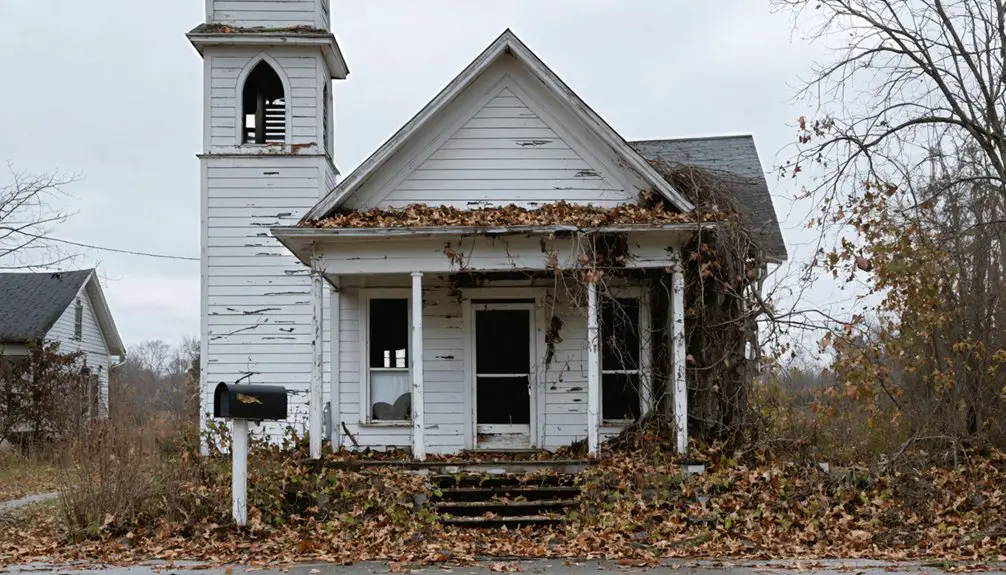
While Saint Annie once thrived as a rural Missouri settlement, its path to abandonment unfolded through a complex web of economic and social changes during the early 20th century.
You’ll find the town’s decline began with the absence of major transportation routes, leaving Saint Annie isolated as regional commerce shifted elsewhere. Economic challenges mounted as agricultural profitability decreased, pushing younger residents toward urban opportunities.
The closure of the post office in 1878 marked a turning point in community decline. The Great Depression and World War II accelerated Saint Annie’s fate, draining its remaining liveliness.
Without modern infrastructure or services to attract new settlers, and faced with an aging population, the town couldn’t sustain itself. Mechanization of farming dealt the final blow, eliminating the need for agricultural labor that had once sustained the community.
Exploring the Ghost Town Today
When you visit Saint Annie’s remains today, you’ll find a stark contrast to its once-vibrant community life. The ghost town beckons urban exploration enthusiasts, though access requires careful planning due to its proximity to Fort Leonard Wood.
- You can spot the old Saint Annie School’s foundation, a silent indication of the community’s educational past.
- The Macedonia Christian Church cemetery remains intact, offering glimpses into local history.
- The Saint Annie Baptist Church bell stands proudly at the Pulaski County Courthouse in Waynesville.
- You’ll need to navigate rural roads near Missouri Route U, about three miles east of Nebo.
- Don’t forget to check military access restrictions before heading to coordinates 37.57198, -92.27405.
While ghost stories echo through the overgrown ruins, remember you’re exploring protected historical ground – take only photos, leave only footprints.
Preserving Saint Annie’s Legacy
Despite limited official records of Saint Annie’s history, dedicated efforts to preserve its legacy continue through multiple channels. Historical documentation from property records and post office archives provides foundational knowledge, while community engagement through oral histories and family stories helps fill significant gaps in the historical record.
You’ll find that preservation efforts focus on both physical and cultural aspects. While Saint Annie lacks the formal preservation infrastructure seen in other Missouri ghost towns like Times Beach, there’s potential to protect remaining structures and landscape features.
Local historical societies can play an important role by recording narratives, including folklore like the “Dirty Annie” tales. Through digital archives, educational programming, and collaboration with Missouri State Parks, you’re helping guarantee Saint Annie’s story endures for future generations.
Planning Your Visit to Saint Annie
Exploring Saint Annie offers a unique glimpse into Missouri’s rural past, but requires careful planning and preparation.
Step back in time to discover Saint Annie’s hidden stories, where Missouri’s pastoral heritage awaits the well-prepared explorer.
You’ll find this historic ghost town just three miles east of Nebo along Missouri Route U, though visitor preparation is essential due to limited infrastructure and services.
- Pack maps, GPS devices, and plenty of water since there aren’t any facilities on-site
- Choose your access routes carefully – stick to Missouri Route U, as other roads may be unpaved or poorly maintained
- Bring appropriate outdoor gear and protective clothing to guard against ticks and snakes
- Check weather conditions and arrive early, as lighting can affect photography of historic structures
- Remember some properties are private – respect boundaries and watch for unstable buildings
Consider combining your visit with nearby ghost towns or Route 66 State Park for a fuller historical experience.
Frequently Asked Questions
Are There Any Documented Paranormal Activities or Ghost Sightings in Saint Annie?
You’d expect spine-chilling ghost encounters in an old ghost town, but there’s no documented paranormal investigation or supernatural activity in Saint Annie – just quiet buildings and normal small-town history.
What Happened to the Original Residents and Their Descendants?
You’ll find original inhabitants likely migrated to urban areas for better opportunities, while their descendants integrated into larger Missouri communities. Limited documentation means many descendant stories remain within private family histories.
Is Camping Allowed on or Near the Saint Annie Site?
You’ll find no direct camping at the site, but camping regulations allow primitive camping in nearby conservation areas and designated campsites at Annie and Abel Van Meter State Park.
Does Anyone Still Own Property or Live in Saint Annie?
Weathered buildings stand silent against open skies. While local legends hint at lingering connections, you won’t find clear property ownership records or confirmed residents in today’s ghost town landscape.
Are There Guided Tours or Local Historians Available for Visits?
You won’t find official guided exploration or established tours here. There’s no documented presence of local historians offering historical insights, so you’ll need to rely on self-guided research and exploration.
References
- https://www.youtube.com/watch?v=xYutGKOOEo4
- https://www.youtube.com/watch?v=O5pdld78XeA
- https://urbexunderground.com/ghost-towns-in-missouri/
- https://kids.kiddle.co/List_of_ghost_towns_in_Missouri
- https://en.wikipedia.org/wiki/Saint_Annie
- https://collections.shsmo.org/manuscripts/columbia/C2366/atchison-county
- https://kids.kiddle.co/Saint_Annie
- https://www.kcur.org/history/2022-07-27/doc-annie-smith-missouri-abortion-ban-urban-legend
- https://stannplattsburg.org/our-legacy-restoration/church-history
- https://villageofstanne.com/wp-content/uploads/2021/06/St-Anne-100-Anniversary-Book-R.pdf

